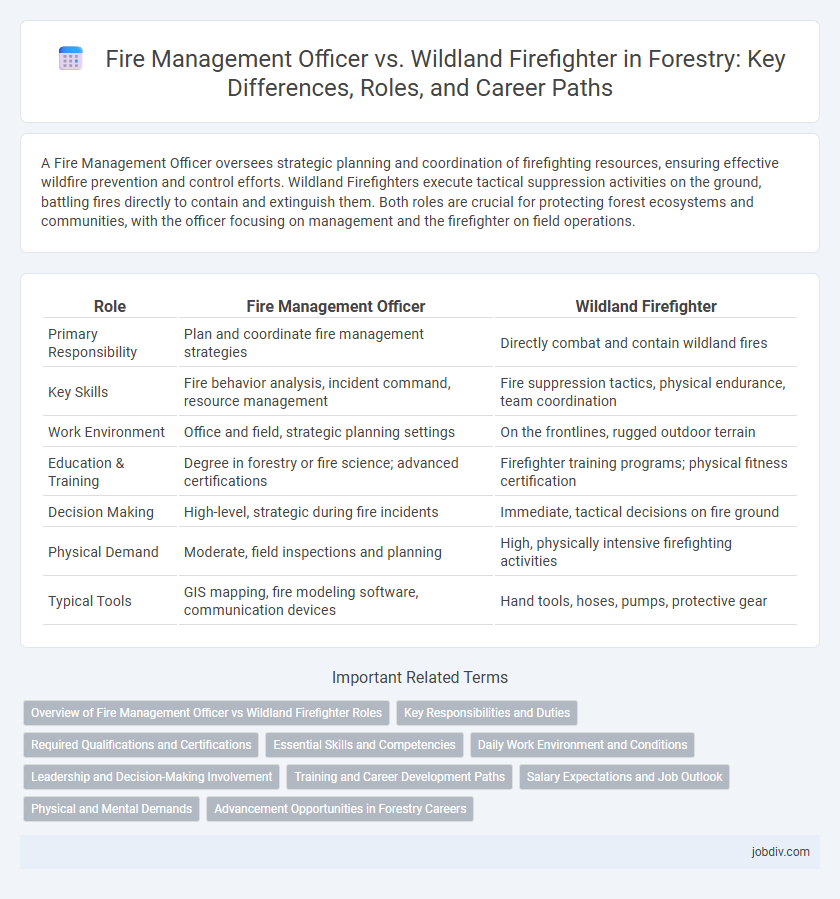A Fire Management Officer oversees strategic planning and coordination of firefighting resources, ensuring effective wildfire prevention and control efforts. Wildland Firefighters execute tactical suppression activities on the ground, battling fires directly to contain and extinguish them. Both roles are crucial for protecting forest ecosystems and communities, with the officer focusing on management and the firefighter on field operations.
Table of Comparison
| Role | Fire Management Officer | Wildland Firefighter |
|---|---|---|
| Primary Responsibility | Plan and coordinate fire management strategies | Directly combat and contain wildland fires |
| Key Skills | Fire behavior analysis, incident command, resource management | Fire suppression tactics, physical endurance, team coordination |
| Work Environment | Office and field, strategic planning settings | On the frontlines, rugged outdoor terrain |
| Education & Training | Degree in forestry or fire science; advanced certifications | Firefighter training programs; physical fitness certification |
| Decision Making | High-level, strategic during fire incidents | Immediate, tactical decisions on fire ground |
| Physical Demand | Moderate, field inspections and planning | High, physically intensive firefighting activities |
| Typical Tools | GIS mapping, fire modeling software, communication devices | Hand tools, hoses, pumps, protective gear |
Overview of Fire Management Officer vs Wildland Firefighter Roles
Fire Management Officers coordinate wildfire prevention, planning, and strategic response efforts to minimize fire impact on natural resources and communities. Wildland Firefighters execute hands-on suppression activities, including fireline construction and direct attack to control and extinguish active wildfires. While Fire Management Officers focus on leadership, policy, and resource allocation, Wildland Firefighters specialize in tactical fire suppression and field operations.
Key Responsibilities and Duties
Fire Management Officers develop strategic wildfire prevention plans, coordinate fire suppression activities, and manage resource allocation during fire incidents. Wildland Firefighters execute hands-on fire suppression tasks, perform controlled burns, and conduct hazardous fuel reduction to protect forested areas. Both roles require expertise in fire behavior analysis, but Fire Management Officers emphasize planning and leadership while Wildland Firefighters focus on operational firefighting.
Required Qualifications and Certifications
A Fire Management Officer typically requires a bachelor's degree in forestry, fire science, or natural resource management along with advanced certifications such as the National Wildfire Coordinating Group (NWCG) Incident Command System (ICS) qualifications and Fire Program Management credentials. Wildland Firefighters generally need a high school diploma or equivalent and must obtain basic NWCG certifications including S-130 (Firefighter Training), S-190 (Introduction to Wildland Fire Behavior), and medical clearance for physical fitness standards. Both roles demand rigorous training in wildfire behavior, safety protocols, and emergency response techniques, but Fire Management Officers often have additional leadership and strategic fire planning qualifications.
Essential Skills and Competencies
Fire Management Officers possess advanced skills in strategic planning, risk assessment, and resource coordination essential for overseeing wildfire suppression and prevention operations. Wildland Firefighters require strong physical endurance, firefighting techniques, and situational awareness to execute direct fire suppression efforts in challenging terrains. Both roles necessitate competency in communication, safety protocols, and adaptive decision-making under high-pressure conditions.
Daily Work Environment and Conditions
Fire Management Officers typically oversee fire prevention strategies, coordinate response efforts, and analyze fire behavior using advanced technology within command centers or offices. Wildland Firefighters engage directly in physically demanding tasks such as fire suppression, constructing fire lines, and emergency evacuation in rugged, remote outdoor environments often exposed to extreme weather and hazardous conditions. Both roles require adaptability, but Fire Management Officers work in strategic planning environments while Wildland Firefighters operate on the front lines of wildfire incidents.
Leadership and Decision-Making Involvement
Fire Management Officers oversee strategic planning and resource allocation, making critical decisions to coordinate wildfire response efforts effectively. Wildland Firefighters execute tactical operations on the ground, following plans while adapting to immediate conditions under the guidance of team leaders. Leadership roles in fire management emphasize situational awareness, risk assessment, and real-time decision-making to minimize damage and ensure crew safety.
Training and Career Development Paths
Fire Management Officers undergo advanced leadership training emphasizing fire behavior analysis, strategic planning, and incident command systems, preparing them to develop comprehensive fire management plans. Wildland Firefighters receive rigorous physical training focused on firefighting techniques, safety protocols, and wildfire suppression tactics, often starting with entry-level crewmember roles. Career development for Fire Management Officers typically progresses through formal education and certification in forestry or fire science, while Wildland Firefighters advance by gaining field experience and specialized skills such as heavy equipment operation or fire aviation support.
Salary Expectations and Job Outlook
Fire Management Officers typically earn higher salaries, averaging between $65,000 and $90,000 annually, due to their leadership and strategic planning roles in wildfire prevention and control. Wildland Firefighters, who engage directly in combating fires, usually earn between $30,000 and $50,000, reflecting their physically demanding frontline duties. Job outlook for both professions remains strong, driven by increasing wildfire incidences and the growing need for skilled personnel in fire management and forest conservation sectors.
Physical and Mental Demands
Fire Management Officers handle strategic planning and coordination, requiring strong decision-making skills and the ability to analyze complex fire behavior data under high-pressure situations. Wildland Firefighters face intense physical demands such as prolonged hiking with heavy gear, handling tools in rugged terrain, and exposure to extreme heat and smoke, demanding exceptional stamina and resilience. Both roles necessitate acute mental endurance, but firefighters must maintain focus during physically exhaustive wildfire suppression operations.
Advancement Opportunities in Forestry Careers
Fire Management Officers typically have broader advancement opportunities in forestry careers due to their strategic role in planning, coordinating, and supervising wildfire prevention and suppression efforts. Wildland Firefighters often start on the front lines and can advance by gaining experience and certifications, potentially progressing into Fire Management Officer positions or specialized roles such as incident command or resource management. Both career paths offer growth, but Fire Management Officers generally access higher-level leadership and policy-making positions within forestry agencies.
Fire Management Officer vs Wildland Firefighter Infographic

 jobdiv.com
jobdiv.com